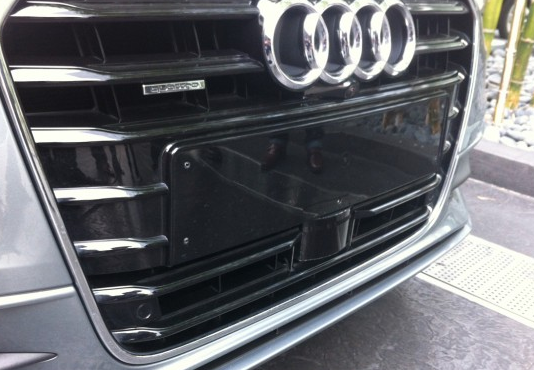In my first CES round-up, I pointed out the buzz Lexus was getting for its self-driving vehicle, which features the well-known Velodyne scanner spinning around on the roof. How I missed Audi’s much-sleeker entry into the lidar-based auto-driving market I’m not sure. It’s pretty rad.
Car and Driver does a great job of summing up the user experience in their blog entry here detailing the test drive:
Traffic-jam assist combines the sensory information from Audi’s existing radar-based adaptive cruise control system and the car’s lane-keeping assist camera (which monitors lane markers) with a compact, bumper-mounted LIDAR (Light Detection and Ranging) laser. Audi is particularly proud of this LIDAR unit, not the least because it packs all of the sensory ability of the giant, roof-mounted LIDAR towers seen on Lexus’s autonomous LS, Google’s fleet of self-driving Priuses, and the Pikes Peak autonomous Audi TT into a brick-sized piece of hardware. Software allows the system to steer the car; if any significant torque is applied to the steering wheel, control is relinquished back to the driver.
Well, I don’t know about “giant, roof-mounted lidar towers.” That seems a bit overblown. But there’s no arguing that Audi’s version is far sleeker:
(For those still not understanding my headline, go here. But only if you have a sense of humor.)
I’d consider this a pretty impressive development. They’ve got 145 degrees of visibility with the lidar sensor, so they neither smack into the car ahead of them nor miss cars trying to cut in front of your car in traffic. All of that while not looking ugly. Well done, Audi.
Engadget got a nice interview from CES in the Audi booth, which was by all descriptions very impressive. It outlines Audi’s vision for the “piloted car” and how the company thinks people will use the functionality:
Am I the only one slightly amused by the constant assurances that the piloted function doesn’t work on the highway because of how fun it is to drive an Audi on the highway and no one would want to give that up? I think they’re just not quite ready to promote it at highway speeds. Try my commute to work in the Hyundai – I don’t think an Audi would make 25 miles on the Maine Turnpike into a laugh riot.
Regardless, all of this activity shows that carmakers are making a real commitment to the capture of 3D data to inform the performance of their vehicles and I think it’s only a matter of time before lidar is built into vehicles of all sorts on construction sites and in industrial facilities for safety purposes.
But think about what else could be done here. What if, while these vehicles were scanning for obstructions, they were also constantly replenishing your as-built point cloud documentation? Like a Viametris unit in the front grill of your bucket loader. Couldn’t you just do a data dump every night and then let it register overnight and, voila, updated point cloud?
Something to consider while you count your pennies in advance of the release of this new A6.






